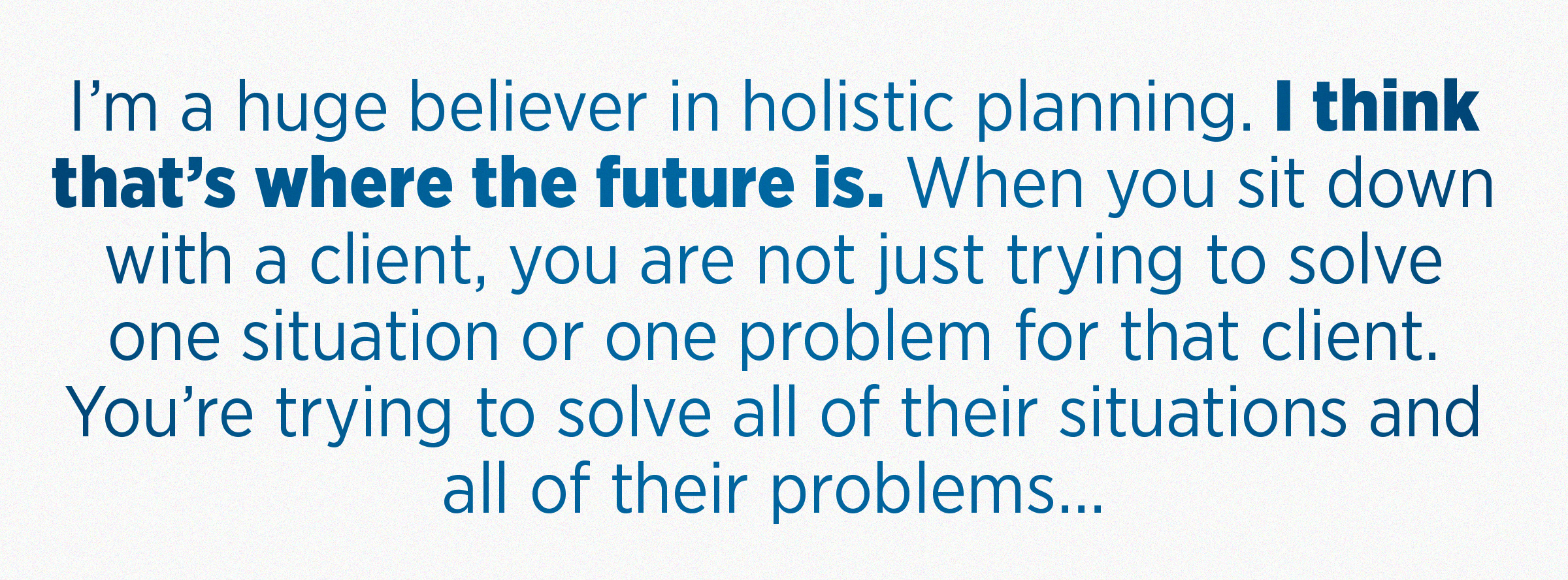Riding the ‘long tail’ of opportunity — with AmeriLife’s Brian Peterson
Brian Peterson talks about his path from teacher and coach to president of AmeriLife Group’s Accumulation and Retirement Income Distribution division, and what the future looks like for one of the industry’s largest marketing and distribution businesses.
When Brian received some questionable financial advice during his early days as a teacher and coach, it drove him to rethink his career. “I was not happy. I mean, after the advisor left abruptly — I asked him to leave — I told my wife, ‘Listen, if he can do this and make money in this profession with the advice he’s giving, what if I were to do it and do it the right way?’” About a year and a half later, he left teaching to become a financial advisor.
That path led to Petersen’s becoming senior vice president of Allianz Life, then president and CEO of TruChoice Financial, and, finally, to his current position at AmeriLife. He calls his career change “the best business decision I’ve ever made.”
Today, with AmeriLife looking to continue its expansion, Peterson says providing agents and advisors with a holistic approach to solving all their clients’ needs is uppermost on his list of goals. And artificial intelligence will revolutionize the speed and accuracy of support, helping advisors deliver the best holistic results for their clients.
In this interview with InsuranceNewsNet Publisher Paul Feldman, Peterson describes how AmeriLife Group has achieved revenues that are on track to hit the $15 billion to $16 billion range this year, with about $11 billion of that in annuity sales.
Feldman: You are a dynamic personality that I have enjoyed knowing in the industry. For those not familiar with you, tell us about yourself and how you got into the industry?
Brian Peterson: I studied to be a teacher and coach in college. A couple years after I began teaching, one of my colleagues came up to me and said, “Hey Brian, I’m starting this new side job, doing it on the weekends. I’m making some good money, and I’d love it if maybe I could bring my sales manager and meet with you and your wife about your finances.” And I told him, “Well, we can certainly do that, but I’m two years out of college, I have a mortgage, I have an auto loan, I have student debt and I have credit card debt. I don’t have a lot of cash, so I’m not sure what you’re going to do for me.”
But he said, “That’s perfect. That’s what we want.” The advice and the recommendations they came back with a week or so after we met were so out of the realm of anything that I felt was — I guess I’d use the word — truthful. I was not happy. I mean, after they left abruptly — I asked them to leave — I told my wife, “Listen, if he can do this and make money in this profession with the advice he’s giving, what if I were to do it and do it the right way?”

About a year and a half after that, I left teaching to become a financial advisor. I started with Prudential. I was a financial services associate. The first part was, like, three months of training down in Dallas as well as getting all my licenses. After that, I was a financial advisor for Prudential for several years and later got a call to interview at this company called Life USA, which was in the process at the time of being purchased by Allianz Life.
I didn’t want to leave what I was doing. I was making good money, and I loved my job, I loved the flexibility. I got my golf handicap down to a five. It was great. Things were good, but we were about ready to have our first child and so I ended up taking the new job. I’ll tell you what — that was the best business decision professionally that I’ve ever made in my life, being at Allianz Life for 22 years. It was just remarkable, and I haven’t looked back since.
In about 2006, I ended up getting into the IMO space. Allianz Life asked me to take over all the IMOs that they owned, which was about 13 at that time. Right now, it’s a little bit of deja vu because we have about 14 IMOs that I’m responsible for. So, 22 years at Allianz Life and at the end of November, I’ll be two years here at AmeriLife.
Feldman: As the president of retirement wealth at the company, what’s your goal? What would you like to accomplish?
Peterson: Obviously, No. 1 is that we want to continue to grow and build and do that organically. Over the last four or five years, AmeriLife has been growing through mergers and acquisitions. That will still be the goal at AmeriLife. We’re still going to do some of that, but we also must grow organically. My job is basically to build out the infrastructure of our organizations, as well as the agent advisor experience.
We must find ways to continue to move down the path of meeting the agent and the advisor where they want to be met, helping them get to their next level, wherever that might be. What do they want to be? Where do they want to go? We can’t stay stagnant. We must grow with them. And that can be anything from helping them build their skillset to leads, seminars, TV, radio. It’s across the board because every advisor, every agent, will be different.
Feldman: AmeriLife is one of the largest distribution companies in the life and annuity market, and Medicare and senior benefit space. Tell me about the company.
Peterson: AmeriLife started in 1971 just outside Tampa, Fla. It started as a life and health insurance agency. They were building retail life and insurance agencies here in Florida, then expanded to Georgia and North Carolina. Today there are more than 50 different retail agencies across about 12 states. In about 1983, AmeriLife went into the annuity brokerage space, and that’s where we are today.
The big change for AmeriLife came in about 2017, when Scott Perry took over, and that’s when the M&A and the growth really happened — not only in organic growth and building from within the accumulation retirement income division. I’m responsible for about 14 affiliates. The majority of what we do is annuities. We’ll touch about $11 billion in annuities this year. AmeriLife as a whole will be about $15 billion or $16 billion. There are other places within the organization — whether it’s through the registered investment advisory channel, the broker-dealer channel, health, life — that are doing another $4 billion or $5 billion in premium.
Feldman: What does next year look like, not only for AmeriLife, but also for the industry? We’ve seen high interest rates over the last few years, which have been great for annuity sales. What happens when that gets kicked back a little bit? Do you think the enthusiasm will continue?
Peterson: I do. We have about 10,000 people a day turning 65 in this country. That’s obviously the No. 1 factor. If you go back a few years ago in the interest rate environment, the 10-year Treasury was probably at 1.5%, 1.25% — maybe it came down to less than 1% for a short time. Even if it comes down from the 4.25% it’s at right now into the 3.5% range, we still have amazing consumer value in our products. When you combine that with where the product is today versus maybe where it was five years ago — even today you have about $6 trillion of assets sitting in money market CDs and savings accounts. Consumers will need to put their money to work somewhere else if that rate goes down into the 3%-3.5% range. Where will they put their money? I think they will put it in fixed indexed annuities. We still have a long tail of positive opportunity remaining.
Feldman: AmeriLife designs and develops very innovative products. Where do you see the future of these products? How are they evolving?
Peterson: Look at 2022 and SECURE 2.0. You have a situation where the opportunity to bring annuities into the 401(k) market opened up. Consumers are finding and hearing the word “annuity,” and they’re learning about annuities much earlier than they ever did. You have 20-year-olds looking at their 401(k), and they might have an opportunity to see some sort of an annuity in there. I think there are folks who are looking at that and thinking, “Wow, they’re kind of coming into our space.” But I see it as education. I see it as making our products more mainstream.
As far as product development in our business, we will continue to grow and make our products more mainstream. We’ll continue to innovate for consumer needs. The products of 10 years ago are so much different than they are today, and I think innovation will continue to happen. The best thing we can do is continue to talk about annuities and get them out there in more ways. We’re at the forefront of that because we’re working with a lot of carriers. We have actuaries on staff here at AmeriLife as well. We’re on the distribution side, and we’re also on the retail agency side.
Feldman: Let’s talk about the retail advisor. What are some things that you recommend or are seeing right now in the advisory space for annuities?
Peterson: I’m a huge believer in holistic planning. I think that’s where the future is. When you sit down with a client, you are not just trying to solve one situation or one problem for that client. You’re trying to solve all of their situations and all of their problems — whatever’s on their mind, you have the ability to solve that. And that’s where I believe the market is going. That’s where it should go. We shouldn’t have somebody go into a client’s house and look at only one product. I think they should have multiple products to offer. We will continue to help the agent and expand their portfolio so they can help more clients.
Feldman: How are you helping agents expand their business?
Peterson: It is really around marketing and education. We have a large marketing team that helps agents and advisors with prospecting and lead generation. How do you go through a portfolio and look at analyzing a portfolio? What software do you want to use with your clients? How do you set up a seminar? How do you get in front of more clients? We’re doing all those kinds of things to help our agents and advisors expand their opportunity, their ability, their skills and their knowledge.
Feldman: What are your thoughts on registered index-linked annuities and their place in the market? Will they continue to grow?
Peterson: Today at AmeriLife, we’ll probably do, from a wholesale perspective, about $100 million in RILAs through our system. I think RILAs are a great product. I think they fit a need for some clients, and I think they’ll fit a need for more clients down the road.
I look at fixed indexed annuities and RILAs working with and against each other, depending on the market. And what I mean by the market is not just the stock market but the interest rate environment. When the interest rates do go back down, I think RILAs will look even better than they do today against what a fixed indexed annuity might look like. RILAs will continue to be a big part of the business model, and we see a bright future for them.
Feldman: AmeriLife is bringing new people into the industry. It’s critical for this industry to grow because a lot of our industry is aging out. How do we bring more agents into the business?
Peterson: That gets into the side of that retail agency model that AmeriLife has, and they are bringing new folks into this business every single day. It is an expensive model though. The training and education and skillset growth within the industry had kind of gone away for a while. It was just about trying to get more sales. If you look at a lot of the large IMOs today, they have a big part of their business in practice management, education, knowledge — all the things that you would look at and you would say those are things that some of the organizations used to do in the ’80s. They’re doing it now.
I see most of the new folks who are coming into our business coming in underneath an experienced advisor or an experienced agent, who’s been in the business for 20 years, and they become a junior for a while. Then maybe they take over that business or go out on their own. But our models are set up to continue to train and educate those folks who are just getting into this business. So, I think we’ve grown leaps and bounds in the last 10, 12 years in the IMO space.
Feldman: Tell us about your infrastructure. What makes AmeriLife different?
Peterson: A couple of things. No. 1 is probably the way we go to the market. We’re looking for partners. We’re looking for people who want to be part of our growth initiatives and our vision and our strategy for the next five years. We’re not looking for folks who are ready to turn in their keys and go retire in the Florida Keys tomorrow.
We’re looking for folks who want to partner. No. 2 is we’re spending a lot of time, effort, resources, money on building that infrastructure, that technology stack, that platform that our distribution partners can tie into — resources that maybe they couldn’t get on their own. I think if you ask a lot of the different organizations out there that look like AmeriLife, we’re all taking the approach of trying to build that tech stack, build that foundation, build that infrastructure.
Feldman: What are you doing that’s exciting on the tech side?
Peterson: AI is obviously a big conversation that’s out there. And I think some people are scared, some people are excited. I think it will revolutionize the speed and accuracy that we can bring to the market. As long as you control it within your controlled environment, it shouldn’t be as scary as people think. I look at it as helping support our field support operations people, our licensing folks, our marketers.
We have well over 50 carriers and probably 300 different products. And to have knowledge of all of those is impossible. But if we put that into our controlled system and environment and use AI to ask a simple question — such as which carriers and products offer increasing income — and I have the answer in three seconds, I am faster, I’m better, I’m stronger than I was yesterday.






The role of life insurance in estate planning and wealth transfer
2025: Taxing decisions due
Advisor News
- Beyond Finance: How an inclusive approach builds client trust
- Study asks if annuities help financial advisors build client relationships
- California’s big pension funds lost billions in stock market selloff. Can they recover in time?
- Economist: Tariffs could dampen GDP growth; raise unemployment, inflation
- Medium tenure for workers remains at about 5 years
More Advisor NewsAnnuity News
- Michal Wilson "Mike" Perrine
- Emerging digital annuity sales process cutting cycle times by 94%, IRI says
- In times of market volatility, FIAs make the difference
- Charitable gift annuities gaining in popularity
- Nationwide and Annexus establish first actively managed mutual fund within a RILA
More Annuity NewsHealth/Employee Benefits News
- CommunityCare names Josiah Sutton new president and CEO
- Strengthening Roots, Shaping the Future: Josiah Sutton Appointed CEO of CommunityCare
- Artificial intelligence was hot topic at Kentucky Chamber’s inaugural Healthcare Innovation Summit
- Cancer coverage for firefighters clears Senate
- New lawsuit challenges Connecticut Medicaid eligibility rules
More Health/Employee Benefits NewsLife Insurance News
- Michal Wilson "Mike" Perrine
- Proxy Statement (Form DEF 14A)
- AM Best Affirms Credit Ratings of Subsidiaries of Old Republic International Corporation; Upgrades Credit Ratings of Old Republic Life Insurance Company
- Proxy Statement (Form DEF 14A)
- Proxy Statement (Form DEF 14A)
More Life Insurance News